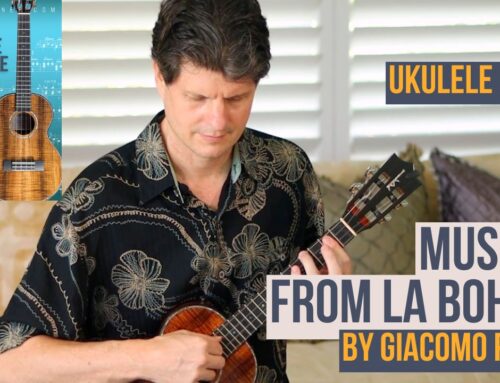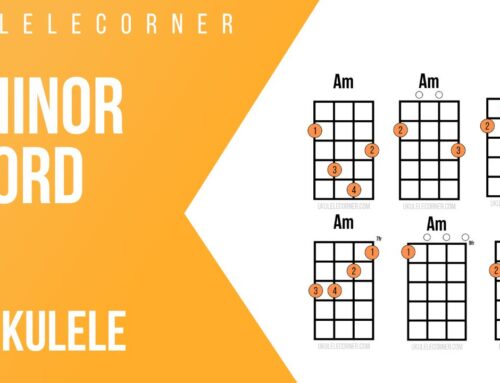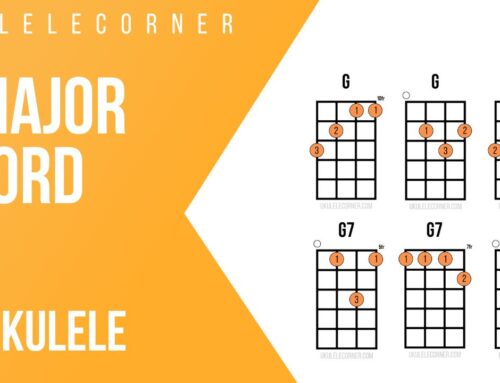In this article we’ll talk about using the mighty rest stroke on fingerstyle ukulele! The rest stroke is a great technique to get a full and loud sound out of the instrument. So let’s dig in.
Right-hand technique
There are many right hand techniques that can be used to produce sound on the ukulele from strumming to fingerstyle. You can use your thumb to strum or to play individual notes. If you use the flesh of the thumb you get a warm sound; if you use fingernail, more volume and brightness. The same is true for the index, middle, and ring fingers: you can use them for either strumming or playing fingerstyle as well. I even like to use the right hand pinky at times when doing rasgueado-style strumming patterns borrowing from the Flamenco tradition.
Free stroke
It is most common to use what are known as “free strokes” when playing fingerstyle. A free stroke clears the other strings after any given string is played. Try placing your index finger on the 1st string and play the open note A. Allow the finger to clear the 2nd string as it moves towards the palm and the note rings out. This is a free stroke. Try the same with your thumb on the 4th string and clear the 3rd string as the note sounds and the thumb moves in a downward motion. This is also a free stroke.
Rest stroke on Fingerstyle Ukulele
Another type of stroke that can be used very effectively to bring out volume and fullness of tone is the “rest stroke.” Like the name suggests, a finger comes to a rest on the next string in the direction of its motion. Try playing the same A note on the 1st string with the index finger but move the finger inward so it comes to a rest on the 2nd string. Do the same on the 2nd and 3rd strings. When the note is played on the 2nd string, the finger will rest on the 3rd string. When the 3rd string is played, the finger will rest on the 4th string. Try the same with the thumb moving from the 4th string resting on the 3rd. Follow up by playing the 3rd string resting on the 2nd and the 2nd string resting on the 1st.
Full, deep sound
Listen to the tone this type of stroke produces. You can dig in and get a full, deep sound with lots of volume. This is wonderful when you want to bring out a melody or bass line. If you are playing a single-line melody that is featured when playing with a group, using rest strokes can project your sound above the accompaniment. With practice you can play solo arrangements highlighting melodies with rest strokes and playing softer accompaniment with free strokes. This is when the magic starts to happen and you can create truly independent parts.
The motion of pushing the string down into the sound hole of the ukulele is what helps produce such a full tone with rest strokes. If you try pulling up when playing a note, moving in the opposite direction away from the sound hole, you will notice a much thinner sound that will distort if you play with a lot of volume. The string may even slap back against the fingerboard producing poor tone (unless you are really going for it playing the Blues!). Rest strokes allow the string to vibrate in a way that avoids that slap back at louder volumes.
Contact, pressure, and release
After you get the hang of playing rest strokes on open strings, try playing single line melodies using the technique. A key part of getting a good tone is to relax the tip joint when using the index, middle, and ring fingers. Before the finger releases from the string you should see it flex back. I think of three stages when playing a string: Contact, Pressure, and Release.
The moment when pressure is applied is when you should see the tip joint flex. This allows for a relaxed motion and warmer tone. If the finger tip is stiff, you will need to force the finger through the string. This adds tension to the right hand and thins out the tone. You should also let the tip joint of the thumb flex back when doing rest strokes. It will curve back a bit before you play a note. Curving the tip of the thumb inward will cause tension. The motion should follow a circular motion moving from the back joint.
Putting the rest stroke into action
After you have spent some time with this technique playing melodies, you can then try combinations of either free strokes with the thumb and rest strokes with the fingers or the opposite with rest strokes with the thumb and free strokes with the fingers. The rest strokes will bring out notes that you want to feature above the free strokes. This is much more difficult than simply playing individual notes.
Try playing a free stroke with the thumb on the open 3rd or 4th string then a rest stroke with the index finger on the open 1st string. Play very slowly and separate the notes. As this starts to feel good, try playing both at the same time. Not easy at first! Try anticipating the note with the thumb slightly before the index finger. Think of the thumb note as a grace note. Relaxing the hand is essential here! Watch to see that the tip joint of the index finger is relaxed and flexing. With practice you will find you can play very lightly using a rest stroke and still get a full sound. Play these two notes together very softly at first then add more volume when it feels comfortable. Eventually you can add rest strokes on top of arpeggiation to create beautiful, singing melodies above flowing accompaniment.
I love using this technique and feel it is definitely worth the effort to learn. I teach this as part of the curriculum of 20 units and 8 grades at the Ukulele Corner Academy. Once you hear the beautiful, rich tone of a rest stroke on fingerstyle ukulele you will be hooked!
Aloha,
Jeff Peterson




Leave A Comment